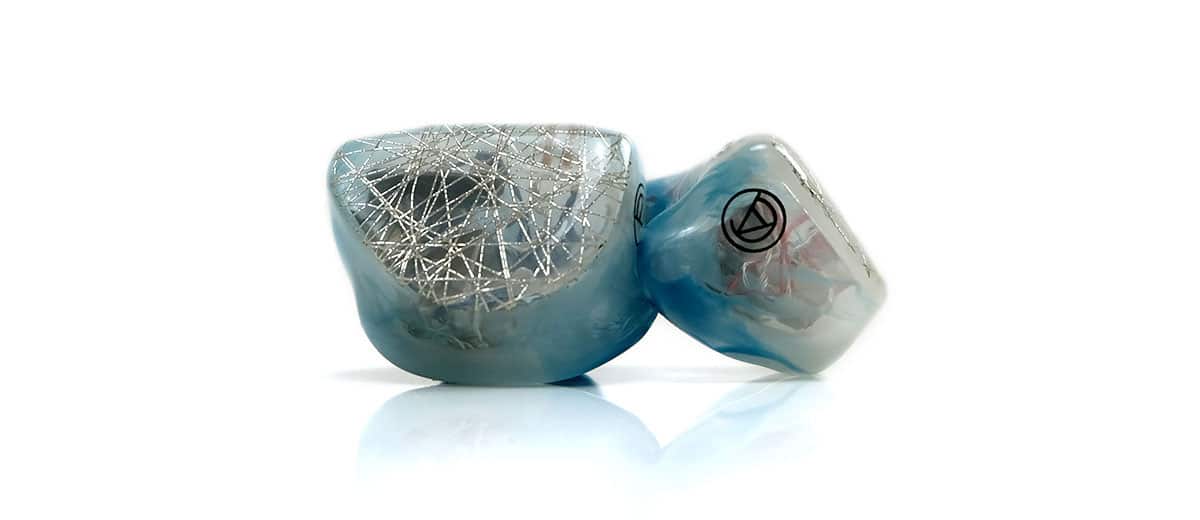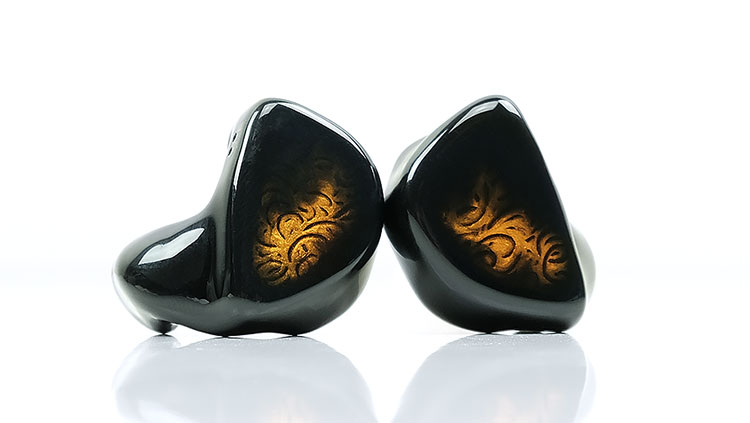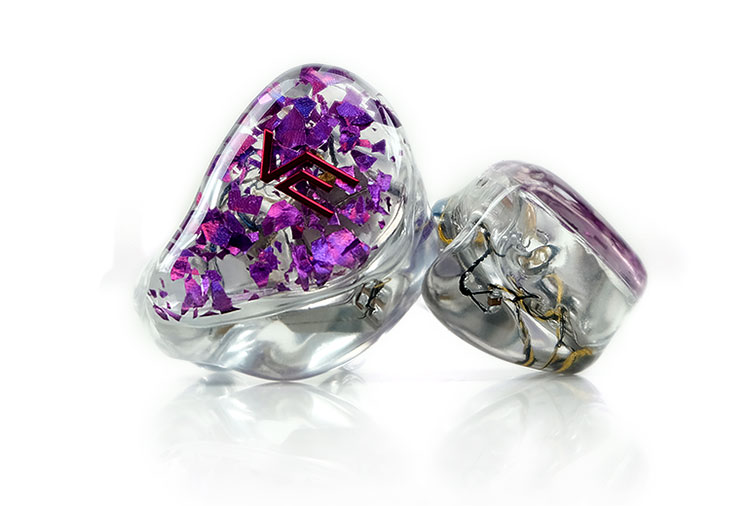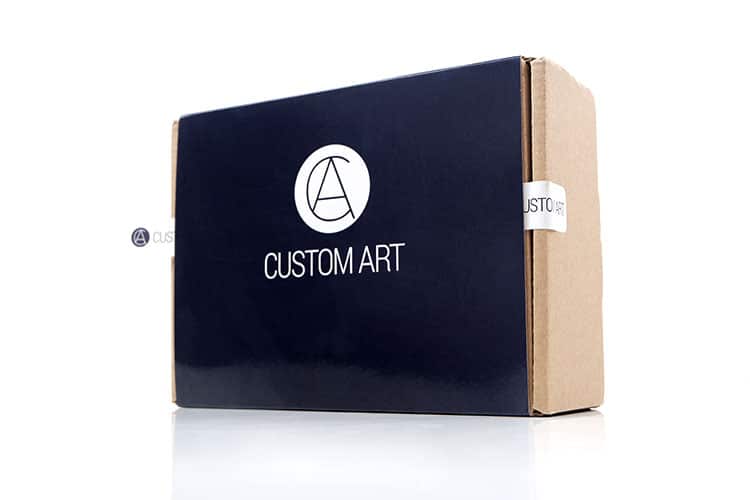Select Comparisons
Custom Art FIBAE 7
The original 7 BA driver flagship launched in 2020 and is now discontinued with the new FIBAE 7 Unlimited replacing it. You can read our full review here.
From €1,100 (Discontinued)
Technical
Like the FIBAE 7 Unlimited, the original is all BA 7 driver implementation. In fact, the actual grouping for both remains unchanged with a dual sub-low woofer, one low-mid, two mid-highs, one proprietary high, and one proprietary tweeter for the super highs.
What has changed is the new active crossover inside the FIBAE 7 Unlimited, as well as a new 3D-printed internal waveguide to allow CA to improve the sensitivity level of the new version over the old as well as extract and improved top-end performance.
The rated efficiency level has changed also going up from 5.9Ω to 12Ω for resistance but improving SPL by 9dB from 113dB to 122dB. Incremental volume steps should have more of an impact on the FIBAE 7 Unlimited volume level compared to the original.
However, I actually found the original to come across as a little louder when volume matched on a low gain setting across a number of test DAPs including the new Cayin N8ii and the older Lotoo PAW Gold Touch. I suspect the higher level of pinna gain from the original’s tuning might have something to do with this perception combined with the slightly lower load.
Design
Since they are both custom-designed monitors the aesthetics will be very different. However, all being well with your mold impressions the fitting should be the exact same, i.e., perfect.
In the case of these two samples, I received there is a minor variation in the fitting and form factor, but both isolate in the exact same excellent manner. The variations include a slightly shorter thicker nozzle on the original and a narrower rear arch on the FIBAE 7 Unlimited version.
The net result is slightly more pressure from the original inside the ear and the FIBAE 7 Unlimited extended a bit further into the canal. Passive isolation is just excellent with both cutting out a lot of background noise.
Aesthetically, beauty is in the eye of the beholder. Both are incredibly unique and bespoke designs with the original using a transparent black shell with an integrated quasi-Inca style black and orange swirl handcrafted faceplate. There is no official name for this but my pet name for it is Inca Orange.
The same for the FIBAE 7 Unlimited version which is a transparent white shell with a baby blue nozzle finish and a form of Japanese wire on the plate to create a rather icy or frosted appearance. Again, like the original, this is an optional extra and will set you back around €200 extra.
Both use the same Null Audio Arete 1.2m 24AWG UP-OCC copper wire for their stock cable but the FIBAE 7 Unlimited version has had a bit of a finishing upgrade for the connectors and barrels so it looks more modern but also a shade lighter for handling.
Performance
Lots of tweaks right across the FR of the FIBAE 7 Unlimited to produce a fairly different type of technical performance as well as some coloration changes when compared to the original.
On the low-end, from 100Hz down to 20Hz the FIBAE 7 Unlimited has a lot more dB amplitude and presence. Both monitors have the same extension but the power and audible rumble are more palpable on the new tuning compared to the old.
Add to that just slightly less upper-bass bloom and lower-mids presence that further enhances the perceived bass to mids separation on the FIBAE 7 Unlimited. That’s a good move because of the slightly lower 1-4k gain in the new tuning but in doing so the timbral coloration is just a shade cooler.
The second most noticeable change is that pinna gain region of 1-4k which runs a little below the Harman Target compared to the original FIBAE 7 that stretched a fair bit above. That strong vocal focus on the original tuning is now replaced by something a little more relaxed but also in terms of staging imaging a little further back also.
To support the vocal vibrancy the upper mids on the FIBAE 7 Unlimited have a bit more of a lift from 5-7k compared to the old. You get a little more energy, a slightly cleaner tone to higher pitching vocal timbre, and some necessary bite in percussion.
Notes no longer sound quite as rounded as the original, have a bit more air and space to breathe, and as consequence do not fall as far behind as the original’s strong vocal focus.
These changes will enhance your perception of a larger soundstage on the FIBAE 7 Unlimited with vocals a little further back, depth and power enhanced, and improved treble clarity.
Westone ES80
The ES80 was reviewed by us back in 2018 and it still is Westone’s flagship custom monitor to this day. You can read our full review of the ES80 here.
$1899
Technical
Like the FIBAE 7 Unlimited, the ES80 is an all-BA driver design but with a total count of 8 rather than 7. The grouping is therefore quite different with a dual low, dual mid, and a quad BA driver implementation for the highs using a passive 3-way crossover. That’s one less driver for the mids but 2 more for the highs compared to the FIBAE 7 Unlimited configuration.
The is no specific mention of how Westone has designed the internal acoustics in the same manner as the FIBAE 7 Unlimited’s 3D-printed wave design save for the nozzle bore exit which is a horn design rather than CA’s direct exit at the tip of the nozzle.
Horn nozzles allow the different bore sound waves to mix freely first in the recessed portion of the horn before entering your ear canal as opposed to the separate signals firing directly into your canal and mixing there. The pitch is that HF waves tend to come through clearer with a horn design.
The ES80 is rated at a very high 80Ω resistance and a moderate 111dB SPL compared to the much more efficient 12Ω and 122db SPL rating for the FIBAE 7 Unlimited. You need a heck of lot more juice to power the Westone compared to the FIBAE 7 Unlimited.
Design
You really do get a lot of design for your money with the ES80. I mean both have super interesting design qualities but the ES80 copper precious metal flake design combined with the almost matte or rough texture of the Cold Pour acrylic shell is perhaps one of my all-time favorite custom builds.
It is definitely the bigger of the two monitors also with the FIBAE 7 Unlimited feeling somewhat smaller in your ear though both isolate to the exact same level given they are exact fits and have no dynamic driver venting.
You can take your pick also in your preferred termination, either MMCX or 2-pin for both designs, and I do like the low-profile nature of the MMCX build we have here for the ES80.
Generally, most will pick a connection system that suits them best for their own set of cables since the stock Westone cable that comes with the ES80 is nowhere near as good as the Null Arete that comes with the FIBAE 7 Unlimited.
Having said that, Westone does have an ace up its sleeve with the inclusion of ALO Audio’s Reference 8 cable which is an 8-wire silver-plated copper and OCC copper geometry. It does perform really well but aesthetically it is a bit old school in being slightly stiffer and more microphonic compared to the 4-wire Arete.
Performance
The ES80 is closer to the FIBAE 7 in terms of having a stronger midrange and vocal focus and would likely be sitting close or slightly above the Harman Target from around 1-4k.
However, unlike the original, the ES80 is more neutrally tuned and definitely flatter sounding compared to the FIBAE 7 Unlimited.
Those 4 BA drivers in the ES80 highs are just a little more elevated than its dual BA drivers low-end tuning to my ear giving the timbre a neutral to slightly bright tonality through the mids and highs.
Conversely, the FIBAE 7 Unlimited is much more elevated on the lows below 100Hz. You get more power, more body, and also a little more warmth. You get a stronger bass fundamental though the ES80 does seem to have a stronger mid-bass punch.
There is less pinna gain from the FIBAE 7 Unlimited, vocals are a little further back and they also sound more natural. The ES80 is cleaner sounding, further forward in terms of imaging, and will suit those who like a more intimate setting for their vocal performances.
Treble extension is a toss-up, but there does seem to be some elevated lower treble energy on the ES80 which might be seeping into its forward mids giving it that crisper coloration. It can create a little more fatigue than the FIBAE 7 Unlimited with brighter mixes or poor source matchups.
Overall, the FIBAE 7 Unlimited is tuned to deliver a stronger perception of space whereas the ES80 is more center focused within a more intimate or rounded soundstage quality.
Vision Ears VE7
Vision Ears launched the 7-driver VE7 just last year in a custom format. It was rated quite highly by us and you can read the review in more detail here.
Priced from €1850
Technical
The Vision Ears VE7 is perhaps one of the new prominent all-BA driver custom monitors out there besides the FIBAE 7 Unlimited. Seven seems to be a rare number in this business unless you are talking hybrids.
The VE7’s driver grouping is similar but not exactly alike with 2 woofers for the lows, 2 for the lower mids, 1 full range for the mids, 1 for the mid-highs, and a tweeter for the super highs. All knitted together using a 5-way passive acoustic/electric crossover.
The FIBAE 7 Unlimited also uses 2 for the lows but swaps it around with just one for the lower mids and 2 for the mid-highs and then splits the highs with two drivers including a tweeter for the super highs.
Both designs have some drivers which use a more open design though I am not sure they are the exact same models with the VE7 using new vented Knowles drivers with a slow roll-off for the woofers and CA using top-firing designed drivers.
The VE7 is rated similarly at 12Ω with a slightly lower 116dB SPL on paper compared to the 122dB SPL of the FIBAE 7 Unlimited. In real-world testing, both are easy enough to drive, though the FIBAE 7 Unlimited is definitely less efficient compared to the VE7 requiring a few dB more to volume match.
Design
As with our previous comparisons, the VE7 is a custom design so the aesthetic is very unique to both your preference and what the company has to offer from their own in-house artists.
Both styles are unique but I would give an edge to the FIBAE 7 Unlimited design I picked out over the slightly simpler VE7 offering.
The all-over transparent combined with baby blue and wiring feels more thorough or more intricate. The purple flaking and transparent shell of the VE7 comes up nicely in the pics but is slightly more basic looking side by side in real life.
The VE7 is also the larger of the two customs with a slightly thicker nozzle compared to my FIBAE 7 Unlimited sample. It also looks a little more ‘chiseled’ in its contouring and perhaps slightly more intricate in its fitting as a result.
The isolation on the VE7 is a little bit better than the FIBAE 7 Unlimited version I have here due to the slightly thicker nozzle on the VE7 which seals amazingly well though it does mean more ear canal pressure. The CA design is a shade more relaxed and might be preferred by those who want more comfort over isolation.
No question the Null Audio Arete UP-OCC 4-wire copper cable that comes with the FIBAE 7 Unlimited is superior to the basic 4-wire P1 styled stock cable included with the VE7. You are going to want to upgrade the Vision Ear cable to something better, both in terms of looks and dynamics.
Performance
A very competitive comparison and your choice might come down to one of personal preference. There are a number of reasons for that but the first thing that does jump out is the treble tuning differences between these two.
From around 5-7k onwards to 10k the Vision Ears tuning is very much on an upwards curve peaking closer to 8-10k. The FIBAE 7 Unlimited has more lower-treble emphasis with a seamless 4-7k transition that rarely dips and then it fades with far less presence around 10k compared to the VE7.
That’s a fundamental difference that affects both the tone of the mids and the presence of the treble between the two. The VE7 does have more of an ethereal clean or pure treble tone that in turn gives more of a lift to its mids’ odd harmonic timbral balance.
Higher pitching timbre is slightly ethereal in quality on the VE7 but not brittle either, almost electrostatic in quality and articulation. Whereas the FIBAE 7 Unlimited is a little more muted and softer in its upper treble delivery which, in turn, produces a more rounded tone for the mids. A little less sweetness you could say but smoother in its delivery.
Vocals also seem slightly more lifted on the VE7, a bit further forward with more separation between them and the instrumental imaging. Again, you could argue the VE7 treble overtone is injecting a bit more of a vibrant quality to how they sound.
Both have a good sub-bass response though I think the VE7 has a shade more quantity below 80Hz and with a slower drop post-100Hz, it delivers a bit more presence and heft. The FIBAE 7 Unlimited has more of a scooped mid-to-upper bass curve delivering a stronger perceived mids and bass separation.
Our Verdict
If you never got a chance to demo the original, then the new FIBAE 7 Unlimited is an excellent introduction to high-end custom monitors.
For FIBAE 7 owners then the new version will correct any issues you had with the vocal forwardness of the original. At the same time, it will beef up those lows and balance out the highs to deliver a more expansive and potentially more emotive successor.
This is a custom monitor that gels really with just about any source you throw at it. It retains that inviting agreeability of the original but at the same time responds and scales with sources known for their dynamic range.
Cannot forget those unique designs from Custom Art either. I encourage you to take a look at their bespoke design gallery. Like the excellent tuning, there is a lot of imagination at work here to make some great-looking customs.
Custom Art FIBAE 7 Unlimited Specifications
- Dual Sub-Low, single Low-Mid, dual Mid-High, single proprietary High, single proprietary Super High
- Two Top-Firing Balanced Armature Drivers
- Flat Impedance technology
- 122 dB @1kHz @0.1V
- 12 Ohm @1kHz (+-1.7 Ohm 10Hz-20kHz)
- 10Hz-21000Hz (+-20dB into IEC 60318-4 coupler)
- Null Audio Arete OCC Copper cable
- Custom or universal fit





